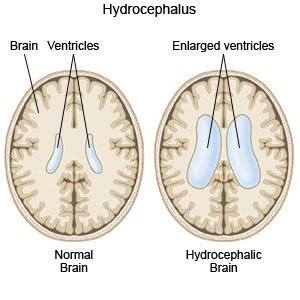Hydrocephalus
Medically reviewed by Drugs.com. Last updated on Apr 6, 2025.
Hydrocephalus is a condition caused by too much cerebrospinal fluid (CSF) inside the ventricles of your brain. Ventricles are spaces inside the brain where cerebrospinal fluid (CSF) is made and held. CSF surrounds and helps cushion your brain and spinal cord. CSF also provides nutrients to your nervous system. CSF is constantly being made and absorbed by your body. CSF moves through ventricles before it drains out and gets absorbed into your bloodstream. When CSF cannot drain properly, the fluid pressure may cause the ventricles to swell.
 |
DISCHARGE INSTRUCTIONS:
Call your local emergency number (911 in the US), or have someone call if:
- You had a seizure.
- You feel sleepy, or have problems waking.
Seek care immediately if:
- You have nausea or are vomiting, even after treatment.
- You feel dizzy or your vision changes.
- You have headaches do not get better, even after you take medicine.
- You have a fever and a stiff neck, or you feel confused.
Call your doctor if:
- You have a fever.
- Your neck and shoulders feel sore.
- The skin around your shunt looks red and feels tender.
- You have questions or concerns about your condition or care.
Medicines:
- Medicines can help decrease inflammation or treat a bacterial infection. Medicines may also lower the amount of CSF your body makes.
- Take your medicine as directed. Contact your healthcare provider if you think your medicine is not helping or if you have side effects. Tell your provider if you are allergic to any medicine. Keep a list of the medicines, vitamins, and herbs you take. Include the amounts, and when and why you take them. Bring the list or the pill bottles to follow-up visits. Carry your medicine list with you in case of an emergency.
Treatment options
The following list of medications are related to or used in the treatment of this condition.
Manage hydrocephalus:
- Keep your follow-up visits. Ask your healthcare provider when to return for follow-up visits. You may need CT scans every 2 to 3 weeks at first. Write down your questions so you remember to ask them during your visits.
- Keep a record of your headaches. Rate your headache, such as from mild to severe. Write down what you were doing when the headache started. Also note when you have been sitting or standing for a long time. Healthcare providers may use the headache record to change your treatment if needed.
- Report weight changes. Tell your healthcare providers if you gain or lose weight. Your shunt valve may need adjustment.
Follow up with your doctor as directed:
Write down your questions so you remember to ask them during your visits.
© Copyright Merative 2025 Information is for End User's use only and may not be sold, redistributed or otherwise used for commercial purposes.
The above information is an educational aid only. It is not intended as medical advice for individual conditions or treatments. Talk to your doctor, nurse or pharmacist before following any medical regimen to see if it is safe and effective for you.
Learn more about Hydrocephalus
Treatment options
- Medications for Brain Anomalies incl Congenital
- Medications for Central Nervous System Disorders
- Medications for Hydrocephalus
Care guides
Symptoms and treatments
Further information
Always consult your healthcare provider to ensure the information displayed on this page applies to your personal circumstances.
